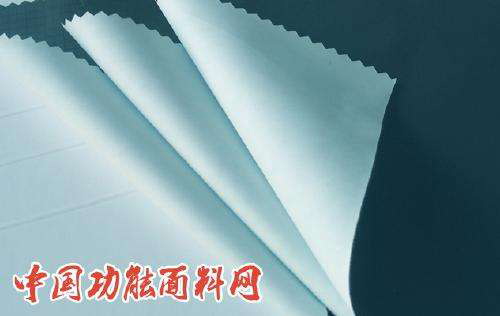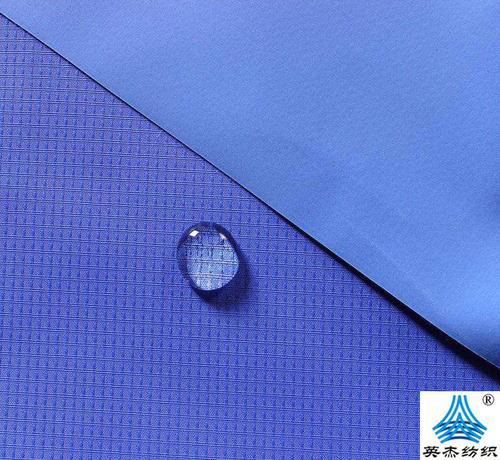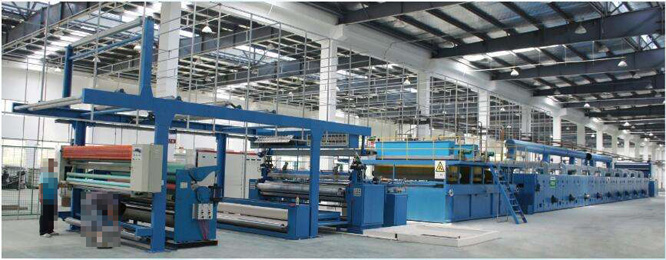Coating finishing
Coating finishing
Coating finishing is a surface finishing technology that evenly coats one or more layers of polymer compounds and other coating agents on one or both sides of the fabric so that the front and back sides of the fabric can produce different functions.
1. Coating finishing characteristics
The treatment is only on the surface. Unlike the traditional finishing and padding, the solution does not penetrate into the fabric. Therefore, chemical raw materials can be saved.
The processes used are mainly calendering, coating, drying and baking. Generally, water washing is not needed, which saves a lot of energy and water and is beneficial to environmental protection.
The base fabric requirements are low, and there is no restriction on fiber variety.
There are many types of coating agents. After adding different additives, the fabric can have various appearances and functions.
2. Types of coating finishing agents
Classification by chemical structure
Polyurethane coating agent
Polyacrylate coating agent
Silicone elastomer
Polytetrachlorethylene resin
PVC coating agent
Classification by reaction performance
Non-cross-linked coating agent
Cross-linked coating agent
Self-crosslinking coating agent

(1) Polyurethane coating agent
There are recurring carbamate groups (-NH-COO-) on the main chain.
According to the structure, it is divided into polyester polyurethane and polyether polyurethane.
According to solubility, there are solvent-based and water-dispersible.
(2) Polyacrylate coating agent
The elasticity of the coating film increases as the number of carbon atoms of the hydrocarbon group (R) in the comonomer increases and the number of (R1) carbon atoms decreases.
The introduction of various types of monomers into comonomers can improve the solubility, reactivity, strength and wash resistance of the coating agent.
It can be divided into solvent type, water-soluble type and emulsion type, with emulsion type having the most applications.
(3) Silicone elastomer
It is a polysiloxane polymer compound containing reactive groups on the main chain.
(4) Polytetrachlorethylene resin
Mostly used for glue coating finishing.
(5) Polyvinyl chloride coating agent
Vinyl chloride is polymerized under the action of initiator.

(6) Non-cross-linked coating agent
The non-cross-linked coating agent is used to coat the base fabric. After the solvent evaporates, a thin film is formed by the cohesion between the polymer compound molecules. No chemical reaction occurs during the film formation process.
(7) Cross-linked coating agent
The cross-linked coating agent contains functional groups such as hydroxyl, amino or carboxyl groups that can react with the epoxy group, N-hydroxymethyl group of the cross-linking agent, forming a stable thermosetting network cross-linked film during the film formation process. .
(8) Self-crosslinking coating agent
The molecular structure of the self-crosslinking coating agent contains reactive functional groups, such as epoxy groups, N-hydroxymethyl groups, etc. Under the action of a catalyst, when coated on the base fabric and treated at high temperature, the coating agent can pass through Self-crosslinking to form a thermosetting network film.
3. Coating methods and equipment
(1) Coating method
Direct coating
Hot melt coating
Bonding Coating
Transfer Coating
1. Direct coating
Direct coating finishing is a method in which the coating agent is directly and evenly applied to the surface of the fabric through physical and mechanical methods and then formed into a film.
According to different film forming methods, it is divided into dry coating and wet coating
(1) Dry coating
Dry coating dissolves the coating agent in water or organic solvents, adds certain additives to make a coating slurry, and directly applies it to the fabric with an applicator. The solvent evaporates, and the coating agent forms a tough film on the fabric surface through its own cohesion or the cross-linking effect of the resin.
Dry coating process
Base fabric → padding waterproofing agent → drying → calendering → coating → drying → additional functional finishing → drying → baking → finished product.

(2) Wet coating
In wet coating, the coating agent is evenly applied to the fabric, and then passed through a water coagulation bath to form a microporous film on the fabric.
Wet coating process
Wet coating process flow: base fabric pretreatment → coating of solvent-based polyurethane slurry → water bath solidification (20℃~30℃) → water washing → calendering → finished product
2. Hot melt coating finishing
Hot melt coating is a coating process in which thermoplastic resin is heated and melted, then coated on the base fabric, and then cooled to adhere to the surface of the base fabric.
Hot melt coating process
The process flow of hot melt coating is: base fabric → coating of molten resin → cooling → calendering → finished product
3. Adhesive coating finishing
The adhesive coating process is to laminate a resin film and a base fabric coated with adhesive and bond them into one body through rolling, or contact the resin film with a high-temperature hot melt roller to melt the surface of the resin film and then The base fabrics are laminated and then bonded into one body by rolling, and the coating film is thicker. Adhesive coatings are commonly used for coating finishes such as upholstery fabrics and floor coverings.
Adhesive coating process
The process flow of adhesive coating is: base fabric → adhesive coating → drying → film bonding → baking → calendering → finished product
4. Transfer coating finishing
The transfer coating is first coated with the coating slurry on the transfer paper treated with silicone, and then laminated with the base fabric, dried and dried under very low tension.Allow to cool gently, then allow the transfer paper to separate from the coated fabric.
Transfer coating is mainly used for coating processing of non-woven fabrics, light fabrics and knitted fabrics that are sensitive to tension.
Process flow
The process flow is: transfer paper → coating coating slurry → base fabric bonding → drying → calendering → cooling → separation of fabric and transfer paper → finished product
(2) Coating equipment
Unwinding device
Coating mechanism
Drying and heat treatment machine
Laminating mechanism
Flattening and corrugating mechanism
Cooling device
Winding device
4. Commonly used coating processes
Fine coating
Wet microporous coating
Transfer Coating
(1) Fine coating
Fine coating, also known as thin coating, is a coating process widely used in agricultural fabrics.
Usually processed by dry coating process, a thin and uniform coating liquid is applied to the surface of the fabric with a floating scraper or roller scraper and dried. A stable coating is formed on the surface of the fabric through solvent evaporation and chemical reaction between coating agents. coating film.
There is no bleeding phenomenon between the coated surface and the non-coated surface.
Breathability and moisture permeability are poor.
Currently it is mainly used for the waterproof coating of ski shirts, raincoats and double-sided fabrics of different colors.
Fine coating process
Coating slurry formula:
Polyacrylate coating agent emulsion 75%
Thickener (polyacrylic acid type) 5%
Cross-linking agent (TMM or DMDHEU) 1%
Defoaming agent (add if necessary) 0.3%
Ammonia 0.7%
Coating process and conditions
Semi-finished product → waterproof pretreatment (reduce the wicking and penetration effect of coating slurry to prevent interference with the reverse side) → coating (coating amount is about 10g/m2) → drying (100~120℃) → baking (150~160℃ )→light calendering→finished product.
(2) Wet microporous coating
Wet microporous coating is a process in which solvent-based polyurethane is directly coated on the surface of the fabric and then wet solidified to form a film.
1. Principle of film formation
First, the strong intermolecular attraction between the hard segments of polyurethane resin macromolecules can form a highly extensible film.
The second is the strong hydrophilic effect of dimethylformamide (DMF) solvent, which has high water solubility. When the polyurethane solution using DMF as the solvent is applied to the fabric and enters the water bath, the DMF in the polyurethane coating phase will continue to form. Diffusion into water, and water diffuses into the interior of polyurethane. As the double diffusion process proceeds, a microporous coating film is gradually formed using the strong cohesion of polyurethane resin macromolecules.
Wet film forming mechanism
2. Wet microporous coating process
Coating slurry formula
100 parts of polyurethane coating agent
15 parts of coloring paint
1 part of non-ionic surfactant
2 parts of anionic surfactant
DMF200 copies
Coating process
Semi-finished products (processed by dyeing and raising) → scraping or padding → solidification → washing → drying.
(3) Transfer coating
The transfer coating process is an important process for the production of artificial leather, also known as the dry artificial leather process.
Transfer Coating Process
Coating slurry formula
Surface adhesive layer
Polyurethane coating agent 100 parts 100 parts
20 parts and 15 parts of ammonium methylformate
20 parts and 15 parts of methyl ethyl ketone or toluene
1 part adhesive-
8 parts of paint-
Cross-linking agent-5 parts
Cross-linking accelerator-1 part
Process flow
Transfer paper → Coating layer → Drying → Cooling → (Coating layer → Drying → Cooling) → Coating adhesive layer → Lamination of raised base fabric → Drying (curing) → Cooling → Peeling → Rolling of transfer paper → Finished product Roll up
Disclaimer:
Disclaimer: Some of the texts, pictures, audios, and videos of some articles published on this site are from the Internet and do not represent the views of this site. The copyrights belong to the original authors. If you find that the information reproduced on this website infringes upon your rights, please contact us and we will change or delete it as soon as possible.
AA







